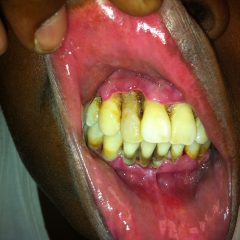Supracondylar Fracture
History of present illness:
A 15-year-old male presented to the emergency department with right elbow pain after falling off a skateboard. The patient denied a decrease in strength or sensation but did endorse paresthesias to his hand. On exam, the patient had an obvious deformity of his right elbow with tenderness to palpation and decreased range of motion at the elbow. Sensation, motor function, and pulses were intact. Radiographic imaging was obtained.
Significant findings:
The pre-reduction films show a type III supracondylar fracture. There is complete displacement of the distal humerus anteriorly. Specific findings for supracondylar fracture include: a posterior fat pad (red arrow) and a displaced anterior humeral line (yellow line).1 When no fracture is present, the anterior humeral line should intersect the middle third of the capitellum; in this X-ray, it does not intersect the capitellum at all. This X-ray demonstrates a normal radiocapitellar line (blue line) that intersects the capitellum. The presence of a narrow anterior fat pad aka “sail sign” can be normal.
Discussion:
Supracondylar fractures of the humerus occur at the distal portion of the humerus without involving the growth plate.2 This is the second most common fracture in children overall. In children, it is the most common fracture of the elbow.3 This injury has a high risk of neurovascular compromise, such as compartment syndrome or ischemic contracture, and thus the clinician must perform immediate and frequent neurovascular assessments focusing on the distributions of the brachial artery in addition to the median, ulnar, and radial nerves.4 Hyperextension injuries that typically occur following a fall onto an outstretched arm are responsible for 95% of supracondylar fractures.1 A type I supracondylar fracture is non-displaced and can be treated with immobilization through a posterior splint and sling5 with close follow-up, type II is angulated but with an intact posterior cortex and can be treated either surgically or with immobilization, and type III is completely displaced and requires orthopedic intervention and surgery.1,4 Due to the unstable nature of these type III fractures, rapid anatomic reduction is recommended followed by further orthopedic surgical stabilization.2 Orthopedic consultation should be obtained in the following scenarios: open fracture, neurovascular compromise, compartment syndrome, and a type II or III fracture.5
Topics:
Orthopedics, ortho, musculoskeletal, supracondylar fracture, pediatrics.
References:
- Carson S, Woolridge DP, Colletti J, Kilgore K. Pediatric upper extremity injuries. Pediatr Clin North Am. 2006;53:41-67. doi: 10.1016/j.pcl.2005.10.003
- Rab GT. Pediatric orthopedic surgery. In: Skinner HB, McMahon PJ, eds. Current Diagnosis and Treatment in Orthopedics. 5th New York, NY: McGraw-Hill; 2014:517-567.
- Cheng JC, Shen WY. Limb fracture pattern in different pediatric age groups: a study of 3,350 children. J Orthop Trauma. 1993;7(1):15-22.
- Marquis CP, Cheung G, Dwyer JSM, Emery DFG. Supracondylar fractures of the humerus. Curr Orthop. 2008;22:62-69. doi: 10.1016/j.cuor.2007.12.002
- Wu J, Perron AD, Miller MD, Powell SM, Brady WJ. Orthopedic pitfalls in the ED: pediatric supracondylar humerus fractures. Am J Emerg Med. 2002;20(6):544. doi: 10.1053/ajem.2002.34850





